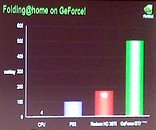Sunday, May 25th 2008

New NVIDIA GeForce GTX280 Three Times Faster than HD 3870 in Folding@Home
Just a couple days ago, we informed you that NVIDIA had joined the Folding@Home team. However, at the time, benchmarks for this new client were unavailable. I am now happy to inform you that (internal) benchmarks are available for your viewing pleasure. The rather large green bar was achieved using the new NVIDIA GPU core, the GTX280. As far as exact numbers go, this sucker can fold at 500 mol/day, which is much higher than the Radeon HD 3870 numbers (170 mol/day), five times higher than PS3 numbers (100 mol/day), and astronomically higher than the average computer numbers (4 mol/day). Whether or not this translates into actual gaming performance is yet to be seen, however, it's pretty hard to imagine how something so powerful wouldn't bring back some respectable FPS in games like Crysis.
Source:
Nordic Hardware

83 Comments on New NVIDIA GeForce GTX280 Three Times Faster than HD 3870 in Folding@Home
As I always say: wait and see.
As for the 38xx series, they perform verry well for their price. They are beat by Nvidia, but not owned.
PS3s cell processor assists in the folding if Im not mistaken, but its actually the nvidia part that does most of the work. I of course, could have that backwards.
so F@h analyzes moles of molecules, making dr. pepper's joke true lol
well, any of us who've taken part in the F@H project know that each console is otpimized for what it's supposed to be working with - they literally pick the work load for each specific console which is optimized for specific hardware to run it best
so, seeing as how SMP work units are optimized for multi-core processors, and CPU clients are optimized for single-core processors . . . the GPU client we've had for our ATI cards runs WUs that are optimized for a GPU, and the PS3 client runs optimized WUs for it's processing architecture . . .
my thought, then - what's to say that nVidia's graph isn't just comparing what their unit IS capable of, but incorrectly compairing different types of processing - sure, their new hardware might be able to process 500 molecules a day, but that doesn't really mean much in the overall scheme of things if it's processing simple molecule WUs instead of more complex units like the SMP client can handle . . .
. . . not sure if I'm making any sense with this, I feel like I'm rambling :ohwell:
i'm wondering what kind of core the wu thats used in the graph based on? is it even based on a wu? is this just processing power? or is this theoretical? what is the basis for the data for other things? what wu's are the other things in the graph running?
makes me think this is some theoretical processing power BS